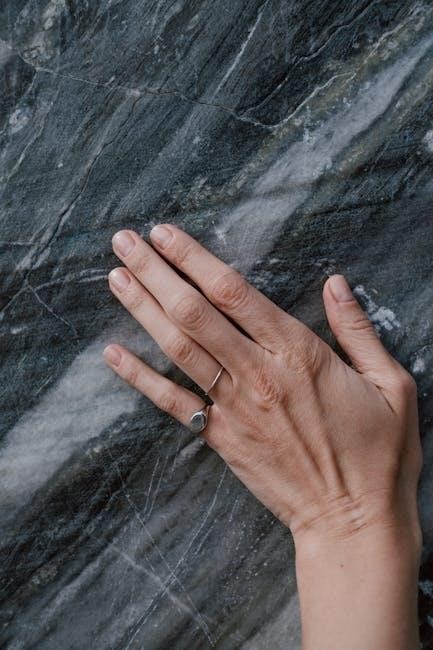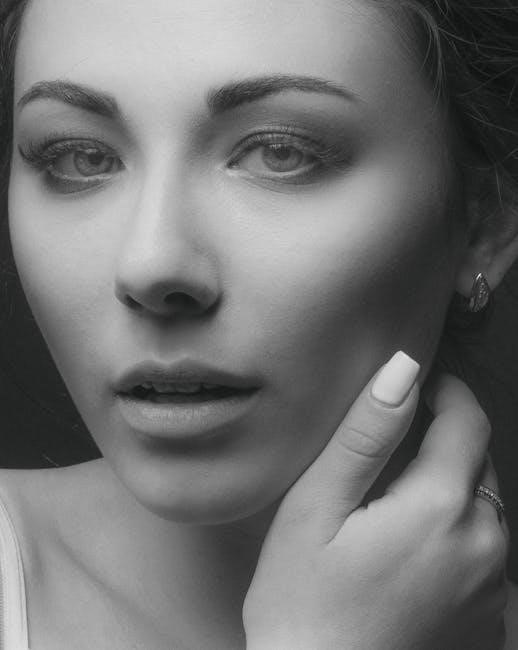Classic lash mapping guides are essential for lash artists, enabling precise customization of lash extension applications. They ensure consistency and desired aesthetic outcomes, enhancing natural beauty with tailored designs.
1.1 What is Lash Mapping?
Lash mapping is a personalized technique used by lash artists to plan and visualize eyelash extension placement; It involves measuring and marking the natural lash line to create a guide for applying extensions. This process ensures lashes are strategically placed to enhance the client’s eye shape, desired style, and natural beauty. By dividing the lash line into sections, artists can customize length, curl, and thickness for a seamless look. Lash mapping is a foundational step in both classic and volume lash applications, allowing for precise customization and a natural, polished finish. It helps achieve symmetry and balance, making it a vital tool for delivering tailored results that meet individual preferences and aesthetic goals.
1.2 Why is it Important for Lash Artists?
Lash mapping is crucial for lash artists as it ensures precise, customized results tailored to each client’s unique features. By creating a detailed guide, artists can strategically place lashes to enhance natural beauty, balance eye shapes, and achieve desired aesthetics. This technique allows for consistency and symmetry, preventing unevenness and ensuring client satisfaction. Lash mapping also enables artists to avoid common mistakes, such as improper placement or mismatched lengths, by providing a clear framework. It empowers artists to deliver personalized styles, whether natural or dramatic, making it an essential skill for mastering lash artistry and elevating client experiences.

Tools and Materials Needed
Essential tools include gel pads, markers, adhesive, tweezers, lash extensions, and measuring guides to create precise, customizable lash maps for various eye shapes and styles effectively.
2.1 Gel Pads and Markers
Gel pads and markers are indispensable tools for creating precise lash maps. Gel pads are placed under the eyes to protect the skin and provide a smooth surface for marking. Markers, typically brightly colored, are used to outline the lash line and divide it into sections. They help technicians visualize the placement of lashes, ensuring symmetry and balance. These tools are especially crucial for maintaining accuracy during the mapping process. By using gel pads and markers, lash artists can create a clear guide for where to apply extensions, making the process more efficient and effective. They are essential for achieving a polished, professional finish in classic lash mapping.
2.2 Choosing the Right Adhesive
Choosing the right adhesive is crucial for a successful lash extension application. The adhesive must be selected based on the client’s eye sensitivity, lash type, and environmental conditions. High-humidity adhesives are ideal for areas with high moisture, ensuring long-lasting results. Classic lash adhesives are typically gentler and suitable for most clients, while stronger options are reserved for volume or hybrid sets. It’s essential to pair the adhesive with a primer to enhance retention and minimize irritation. Proper adhesive selection ensures a secure bond, preventing premature shedding and promoting client satisfaction. Always follow safety guidelines and perform a patch test to avoid allergic reactions. The right adhesive is the foundation of a durable and flawless lash application.

Step-by-Step Guide to Creating a Lash Map
Start by measuring and marking the natural lash line, then divide it into sections for balanced application. This ensures a customized, visually appealing lash design tailored to each client’s eye shape and desired style.
3.1 Measuring and Marking the Lash Line
Measuring and marking the lash line is the foundation of creating an accurate lash map. Begin by placing gel pads under the client’s eyes to protect the skin. Using a brightly colored marker, carefully mark the inner and outer corners of the lash line, ensuring precision. Next, identify the halfway point of the lash line and mark it. These reference points help divide the lash line into sections, guiding the placement of lash extensions. Proper measurement ensures symmetry and customization, catering to individual eye shapes and desired styles. This step is crucial for achieving a balanced and visually appealing lash design, whether for natural or dramatic looks.
3.2 Dividing the Lash Line into Sections
After marking the lash line, divide it into 3-5 equal sections for precise application. This step ensures even distribution and symmetry, enhancing the natural look. Each section corresponds to specific lash lengths and curls, allowing customization. For example, shorter lashes are placed at the inner corner, gradually increasing in length toward the outer corner. This technique maintains balance and prevents overcrowding. Proper sectioning guides the artist to apply lashes that complement the client’s eye shape and desired style. It also helps in achieving a seamless blend between natural and extension lashes, ensuring a polished finish. This method is versatile, suitable for both natural and dramatic lash designs.
Popular Lash Mapping Styles
Popular styles include Cat Eye for dramatic looks and Doll Eye for soft, voluminous appearances, each tailored to enhance specific eye shapes and client preferences effectively.
4.1 Cat Eye Lash Mapping
Cat Eye lash mapping is a popular style that creates a dramatic, elongated look. It involves placing shorter lashes at the inner corner and gradually increasing length toward the outer corner, forming a subtle wing. This technique enhances the eye’s natural shape, making it appear more defined and almond-like. Ideal for clients seeking a bold yet timeless aesthetic, Cat Eye mapping is versatile but may not suit all eye shapes, such as downward-turning eyes, as it can create a droopy effect. Artists use gel pads and markers to mark the lash line, ensuring precise placement. The Cat Eye style is a classic choice for those wanting a striking, eye-catching appearance, and when executed correctly, it delivers a flawless, polished result that complements various eye shapes and personal styles.
4.2 Doll Eye Lash Mapping
Doll Eye lash mapping creates a wide-eyed, innocent look by focusing on longer lashes in the center of the lash line. This style emphasizes volume and length in the middle, with shorter lashes at the corners, giving the illusion of larger, more open eyes. It is ideal for round or hooded eyes, as it counterbalances the eye shape and creates a more balanced appearance. The Doll Eye technique involves careful placement of lashes to enhance the natural beauty of the eyes while maintaining a soft, natural look. Gel pads and markers are used to map the lash line, ensuring symmetry and precise application. This style is perfect for clients seeking a youthful, vibrant aesthetic that enhances their natural features without appearing overly dramatic.

Customizing Lash Maps for Different Eye Shapes
Customizing lash maps for different eye shapes ensures lashes complement natural features, enhancing beauty by tailoring length, curl, and placement to suit almond, round, or hooded eyes perfectly.
5.1 Almond Eyes
Almond eyes are one of the most versatile eye shapes, suitable for a wide range of lash styles. When customizing lash maps for almond eyes, focus on enhancing their natural symmetry and depth. Start by placing shorter lashes at the inner corner to create a subtle, natural look. Gradually increase lash length and volume toward the outer corner for a balanced, elegant appearance. For a dramatic effect, incorporate slightly longer lashes in the middle to accentuate the eye’s natural curve. Ensure the lashes at the outer edge are longest to create a soft, cat-eye effect without overpowering the eye. This approach complements almond eyes perfectly, making them appear larger and more defined. Proper lash mapping ensures a seamless blend of natural beauty and desired style.
5.2 Round Eyes
Round eyes are a stunning canvas for lash extensions, offering a unique opportunity to create elongated, balanced looks. However, they present specific challenges, as excessive volume or improper placement can make them appear smaller. To customize lash maps for round eyes, focus on elongating the eye shape by placing longer lashes toward the outer corners. This creates a more oval appearance and draws attention away from the eye’s roundness. Techniques like cat-eye or winged lash mappings work exceptionally well, as they extend the eye’s natural shape. Avoid heavy volume in the inner corners, as this can make the eyes appear rounder. Instead, use shorter, lighter lashes at the inner corners and gradually increase length and volume toward the outer edges for a balanced, polished look. Proper lash mapping ensures round eyes stand out with elegance and sophistication.
Avoiding Common Mistakes in Lash Mapping
Avoiding common mistakes in lash mapping is crucial for achieving polished, professional results. One of the most frequent errors is improper placement of lashes, which can result in an uneven or unnatural appearance. Another mistake is using incorrect lash lengths or curls that do not complement the client’s eye shape or personal style. Overloading the inner corners with too many lashes can make the eyes appear smaller, while sparse placement in the outer corners may fail to enhance the desired aesthetic. Additionally, inconsistent spacing between lashes can disrupt the seamless blend with natural lashes. To avoid these pitfalls, lash artists must carefully measure, map, and customize each set based on the client’s unique features. Attention to detail and practice are key to mastering lash mapping and delivering flawless outcomes every time.

The Future of Classic Lash Mapping
The future of classic lash mapping is poised for innovation, with advancements in technology and techniques set to redefine the industry. Digital lash mapping tools and AI-driven apps are emerging, enabling artists to create precise, customizable lash plans with greater efficiency. These tools promise to enhance accuracy and reduce application time, making the process more accessible to both professionals and clients. Additionally, the rise of eco-friendly and sustainable lash materials is expected to influence mapping practices, encouraging artists to adopt environmentally conscious approaches. As trends evolve, classic lash mapping will remain a cornerstone of lash artistry, blending tradition with modern advancements to deliver stunning, personalized results for clients worldwide. Continuous education and adaptation will be key for artists to stay ahead in this dynamic field;
Classic lash mapping guides are indispensable tools for lash artists, offering a structured approach to creating bespoke eyelash extension styles. By understanding and implementing these guides, artists can achieve natural, customized looks that enhance clients’ eye shapes and personal preferences. Lash mapping ensures precision and consistency, making it a foundational skill for both beginners and experienced professionals. As trends evolve, the ability to adapt and innovate while maintaining classic techniques will continue to define excellence in lash artistry. Ultimately, classic lash mapping guides empower artists to deliver stunning, tailored results, solidifying their importance in the ever-growing world of eyelash extensions.
